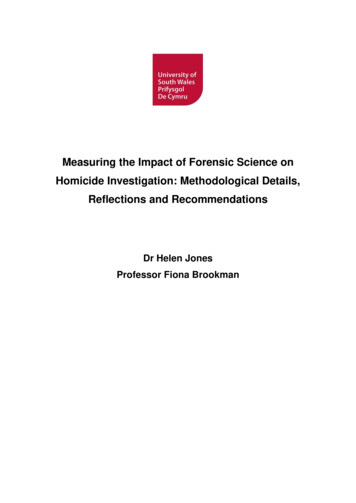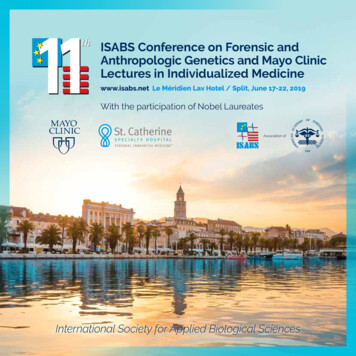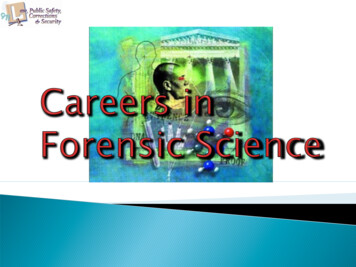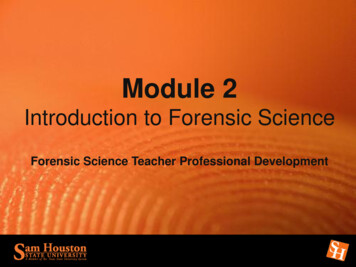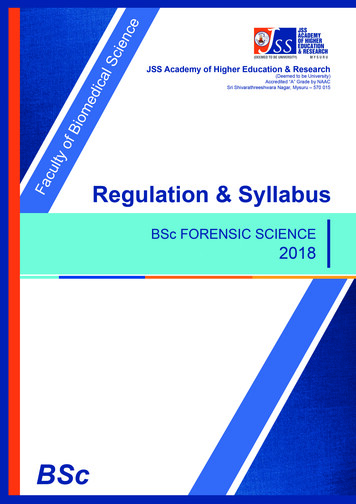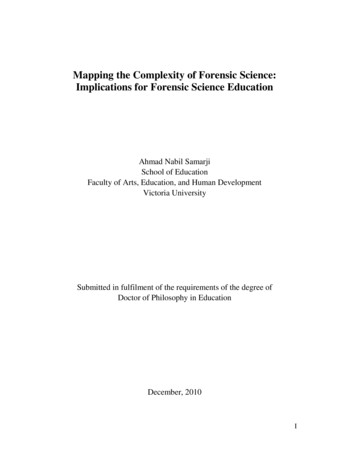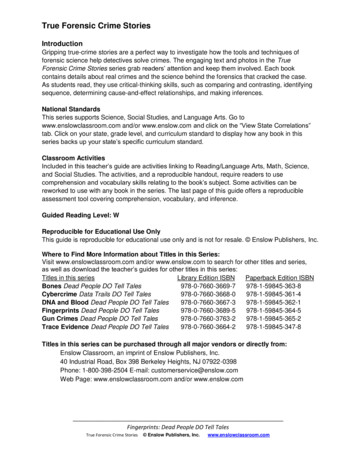
Transcription
True Forensic Crime StoriesIntroductionGripping true-crime stories are a perfect way to investigate how the tools and techniques offorensic science help detectives solve crimes. The engaging text and photos in the TrueForensic Crime Stories series grab readers’ attention and keep them involved. Each bookcontains details about real crimes and the science behind the forensics that cracked the case.As students read, they use critical-thinking skills, such as comparing and contrasting, identifyingsequence, determining cause-and-effect relationships, and making inferences.National StandardsThis series supports Science, Social Studies, and Language Arts. Go towww.enslowclassroom.com and/or www.enslow.com and click on the “View State Correlations”tab. Click on your state, grade level, and curriculum standard to display how any book in thisseries backs up your state’s specific curriculum standard.Classroom ActivitiesIncluded in this teacher’s guide are activities linking to Reading/Language Arts, Math, Science,and Social Studies. The activities, and a reproducible handout, require readers to usecomprehension and vocabulary skills relating to the book’s subject. Some activities can bereworked to use with any book in the series. The last page of this guide offers a reproducibleassessment tool covering comprehension, vocabulary, and inference.Guided Reading Level: WReproducible for Educational Use OnlyThis guide is reproducible for educational use only and is not for resale. Enslow Publishers, Inc.Where to Find More Information about Titles in this Series:Visit www.enslowclassroom.com and/or www.enslow.com to search for other titles and series,as well as download the teacher’s guides for other titles in this series:Titles in this seriesLibrary Edition ISBNPaperback Edition ISBNBones Dead People DO Tell Tales978-0-7660-3669-7978-1-59845-363-8Cybercrime Data Trails DO Tell Tales978-0-7660-3668-0978-1-59845-361-4DNA and Blood Dead People DO Tell s Dead People DO Tell Tales978-0-7660-3689-5978-1-59845-364-5Gun Crimes Dead People DO Tell Tales978-0-7660-3763-2978-1-59845-365-2Trace Evidence Dead People DO Tell Tales978-0-7660-3664-2978-1-59845-347-8Titles in this series can be purchased through all major vendors or directly from:Enslow Classroom, an imprint of Enslow Publishers, Inc.40 Industrial Road, Box 398 Berkeley Heights, NJ 07922-0398Phone: 1-800-398-2504 E-mail: customerservice@enslow.comWeb Page: www.enslowclassroom.com and/or www.enslow.comFingerprints: Dead People DO Tell TalesTrue Forensic Crime Stories Enslow Publishers, Inc.www.enslowclassroom.com
Teacher’s Guide forFingerprints: Dead People DO Tell TalesBecause no two people, not even identical twins, have the same fingerprints, detectives andforensic scientists have used them to catch criminals for more than a hundred years. In thisbook, readers discover how scientists collect and classify prints, and how the prints help toidentify criminals and solve crimes.Before ReadingRemind students that good readers preview a book to find out what they might learn and whatthey already know about the subject. Allow time to read the title, scan the cover photo, andbrowse pages to note the chapter headings, illustrations, captions, sidebars, Chapter Notes,Glossary, and Index. Then have students make KWL charts, writing in the K column what theyalready know about fingerprints and in the W column, questions they want answered about it.After reading, students will add what they learned in the L column.During ReadingReview that sometimes authors use a question-and-answer text structure. They pose questionsin the text to make a personal connection with readers and to encourage them to read on to findanswers. Sometimes an answer is “right there,” word-for-word, but other times, readers mustput together details from the text to locate the answer. Words like who, what, when, where, why,and how signal that an author is using a question-and-answer text structure. A question markcan also be a signal, but sometimes an author’s question is not directly stated. Suggest thatstudents make a Question-and-Answer Chart to keep track of what’s asked and answered asthey read.QuestionWhat makes you unique?Can prints from two people be similar enoughto confuse experts?AnswerIt’s your fingerprints.It’s possible.Also, suggest that as students read, they place a sticky note by any text or photo that answers aquestion they listed on the KWL chart. Students can use the stickies as reference whencompleting their charts.After ReadingHave students complete and discuss their KWL charts. You may wish to have students use theinformation from their charts to create book reviews. Encourage creativity, making a movie-styleposter or newspaper ad to promote the book, or designing a book jacket with illustrations thatsay “pick me up and buy me!” Prompt personal responses to the book by asking: What was themost surprising fact you learned from this book? Which case involving fingerprint evidence didyou find most interesting? Why?Use the Reading/Language Arts, Math, Science, and Social Studies activities on the next page.Make copies of the Handout and Assessment pages that follow for students to do in class or ashomework. Answers: Handout—1.T; 2. F/no one has the same fingerprints as someone else;3. T; 4. F/arch, loop, whorl; 5. T; 6. T; 7. F/some rare people with a disease have no fingerprints;8. T; 9. F/in the 30s; 10. They sometimes do; 11. T; 12. F/some have, not all, that’s the problem;13. T. Assessment—1. A, 2. C, 3. D, 4. A, 5. C, 6. B, 7. B, 8. D, 9. A, 10. C.Fingerprints: Dead People DO Tell TalesTrue Forensic Crime Stories Enslow Publishers, Inc.www.enslowclassroom.com
Curriculum LinksSAFETY WARNING:Make sure students do not have allergies to any materials. Supervise activities using sharp orhot/cold objects. Always review directions and safety rules before students begin any project.NOTE: Fingerprints are personal property, so respect a student’s right to privacy.Each student should make the decision to keep or discard his or her fingerprints.Reading/Language Arts Activity:Revisit the section Privacy Matters on p. 92. Use the questions in the text to prompt adiscussion about fingerprinting. Then ask students to imagine their local government wants tofingerprint every person in the community, from the newest-born baby to the oldest seniorcitizen. Officials say it would help in case of a disaster. Tell each student to write a persuasiveletter-to-the-editor expressing his or her views on the policy, encouraging other citizens to eitherfight the idea or get on board. Let students share their ideas.Math Activity:Have students draw a dark pencil smudge on scrap paper, then rub each finger, one at a time,on the smudge and roll the dark-covered fingertip on paper. If done properly, students shouldsee their fingerprint patterns. Ask students to put their initials on the page and label the prints: Lfor left hand/R for right, T for thumb, I for index finger, M for middle finger, R for ring finger, P forpinkie. Have students use the examples of loops, whorls, and arches in the book to sort theirprints into groups. Finally, ask students to calculate the percentage of each group in yourclassroom and record that data on a pie chart. (#of type / #total students) x 100)Science Activities:1. Have students use magnifying glasses to search for latent prints on classroom desks,chairs, doors, etc. Tell students to dust for prints by sprinkling a little cornstarch on darksurfaces or cocoa powder on light surfaces where they find a print, then gently swipe offexcess with a small paintbrush. Next, have students stick transparent tape over the print,lift it carefully, and place it on paper. Review how to identify arches, loops, and whorls inthe lifted print, and how to match it with one made by a classmate. (See directions in MathActivity above.)2. Let students identify shoeprints. Bring to class a variety of old athletic shoes withdistinctive patterns on the bottom. You can probably get some from friends who arethrowing them out. Choose a volunteer to leave the room while you press one shoe into acookie sheet filled with cornstarch or baby powder, then make several visible shoeprint onthe floor. (Dip the other shoes into the powder as well, so the sight of white powder on oneshoe doesn’t give away the answer.) Call the volunteer back into the room and have himor her study the print and the shoes to try to make a match. Allow the volunteer to choosethe next student to leave the room and to prepare the evidence.Social Studies Activity:Remind students that a timeline shows the sequence of events and dates in the order in whichthey happened. The dates are spaced over a span of time, and seeing the relationships helpsus understand history better. Let students work alone or with partners to research the history offingerprints at www.onin.com/fp/fphistory.html or www.ncjrs.gov/pdffiles1/nij/225321.pdf, thenshow their results in timelines. Encourage students to illustrate the timelines and to site creditfor facts and any pictures.Fingerprints: Dead People DO Tell TalesTrue Forensic Crime Stories Enslow Publishers, Inc.www.enslowclassroom.com
HandoutTrue or False?Read each statement below. Write T on the line if it is true; write F if it is not. IF a statement isfalse, THEN rewrite it on the line provided to make it true.1. Fingertips are tiny raised lines, or ridges, of skin that form patterns.2. Only an identical twin has the same fingerprints as someone else.3. Anthropometry is the science of measuring humans.4. The basic fingerprint patterns are wave, loop, and whorl.5. A focal point is an identical point of comparison between two fingerprints.6. Friction allows your fingertips to grip objects more firmly.7. Every human develops fingerprints by the 19 th week of development.8. Today, lost fingerprints are collected by and stored in electronic machines.9. John Dillinger was the most famous gagster of the 1890s.10. Fingerprint experts never wrongly identify fingerprint samples.11. To log onto some laptops, cellphones, and ATMs, you have to scan your fingerprint.12. All of the world’s countries have devised a universal system to determine how manypoints of similarity in ridge patterns are required to make a match.13. A fingerprint helped catch a person who robbed the author’s neighbor.Fingerprints: Dead People DO Tell TalesTrue Forensic Crime Stories Enslow Publishers, Inc.www.enslowclassroom.com
AssessmentCircle the letter that best completes the statement or answers the question.1. Identical twins have the same DNA, butnot the same fingerprints.A. TrueB. False6. Latent fingerprints are those that areeasily observable.A. TrueB. False2. For many years, scientists believed thatthe ridges of fingerprints evolved as ameans to .A. increase massB. increase Coriolis forceC. increase frictionD. increase gravity7. The technique of taking fingerprints iscalled .A. dermatopathiaB. dactyloscopyC. anthropometryD. digitalfurcation3. The police in which city became the firstin the U.S. to fingerprint suspects?A. ChicagoB. St. LouisC. DenverD. New York City8. If you found fingerprints of someone youdidn’t know inside your house, you couldMOST LIKELY infer that .A. your mother was baking breadB. the President was in town to give aspeechC. aliens had landedD. a burglar had been in your house4. Which was the first murder conviction inthe U. S. based on fingerprint evidence?A. Thomas Jennings, in ChicagoB. Lee Harvey Oswald, in TexasC. Ted Schiffer, in New JerseyD. John Dillinger, in Chicago9. The author implies that crimes canhappen even in the safest community.A. TrueB. False5. Which is NOT a fingerprint pattern?A. whorlB. loopC. triadD. arch10. The MOST LIKELY reason mistakes aremade in fingerprint analysis is .A. the forensic experts are too youngB. no prints are availableC. there’s no agreed-upon standard ofwhat is considered a matchD. the equipment is too oldFingerprints: Dead People DO Tell TalesTrue Forensic Crime Stories Enslow Publishers, Inc.www.enslowclassroom.com
True Forensic Crime Stories Introduction Gripping true-crime stories are a perfect way to investigate how the tools and techniques of forensic science help detectives solve crimes. The engaging text and photos in the True Forensic Crime Stories series grab readers' attention and keep them involved. Each book

